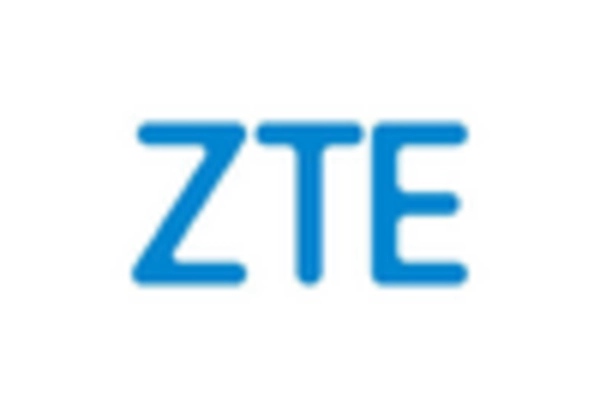Government Initiatives and Support
Government initiatives play a crucial role in the advancement of the 5G Infrastructure Market. Many governments are actively promoting the deployment of 5G networks through funding, policy frameworks, and regulatory support. For instance, various countries have established national strategies aimed at accelerating 5G rollout, recognizing its potential to drive economic growth and technological innovation. The allocation of spectrum for 5G services and the establishment of public-private partnerships are indicative of this support. As a result, the 5G Infrastructure Market is likely to benefit from enhanced collaboration between public entities and private sector players, fostering an environment conducive to rapid infrastructure development and deployment.
Growth of Smart Cities and Urbanization
The growth of smart cities and urbanization significantly influences the 5G Infrastructure Market. As urban populations continue to swell, cities are increasingly adopting smart technologies to enhance efficiency and improve the quality of life for residents. 5G networks are essential for supporting the vast array of connected devices and applications that characterize smart city initiatives, such as traffic management systems, smart grids, and public safety solutions. The integration of 5G technology into urban infrastructure is projected to create substantial economic opportunities, with estimates suggesting that smart city investments could reach trillions of dollars in the coming years. This trend underscores the critical role of 5G infrastructure in facilitating the development of sustainable and technologically advanced urban environments.
Advancements in Technology and Innovation
Technological advancements and innovation are pivotal drivers of the 5G Infrastructure Market. The evolution of technologies such as artificial intelligence, machine learning, and the Internet of Things (IoT) is creating new opportunities for 5G applications. These technologies require robust and high-speed connectivity, which 5G infrastructure can provide. The anticipated growth in connected devices, projected to exceed 75 billion by 2025, further emphasizes the need for advanced 5G networks. As industries explore new use cases, including autonomous vehicles and remote healthcare, the demand for innovative 5G solutions is likely to escalate. This dynamic environment fosters competition among service providers, driving investments in 5G infrastructure and enhancing the overall market landscape.
Rising Demand for High-Speed Connectivity
The demand for high-speed connectivity is a primary driver of the 5G Infrastructure Market. As businesses and consumers increasingly rely on digital services, the need for faster and more reliable internet connections has surged. This trend is evidenced by the projected increase in mobile data traffic, which is expected to reach 77 exabytes per month by 2025. Such a dramatic rise necessitates the deployment of advanced 5G infrastructure to support the growing number of connected devices and applications. Consequently, telecommunications companies are investing heavily in 5G networks to meet this demand, thereby propelling the 5G Infrastructure Market forward. The expansion of high-speed connectivity is not only vital for enhancing user experiences but also for enabling innovations in sectors such as healthcare, education, and entertainment.
Increased Focus on Enhanced User Experience
The increasing focus on enhanced user experience is a significant driver of the 5G Infrastructure Market. Consumers and businesses alike are demanding seamless connectivity and high-quality services. 5G technology promises to deliver lower latency, higher speeds, and improved reliability, which are essential for applications such as virtual reality, augmented reality, and high-definition video streaming. As user expectations evolve, service providers are compelled to upgrade their infrastructure to meet these demands. The competitive landscape in the telecommunications sector further intensifies this focus, as companies strive to differentiate themselves through superior service offerings. Consequently, the push for enhanced user experience is likely to accelerate investments in 5G infrastructure, shaping the future of the market.

















Leave a Comment